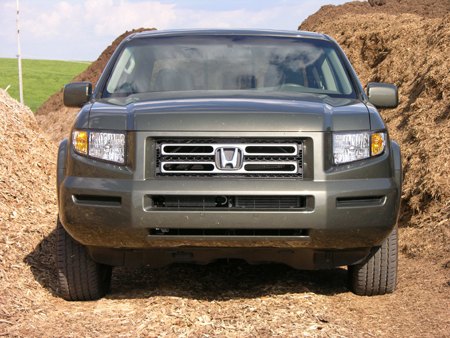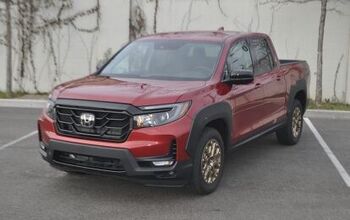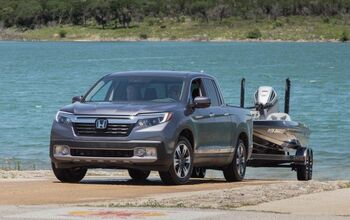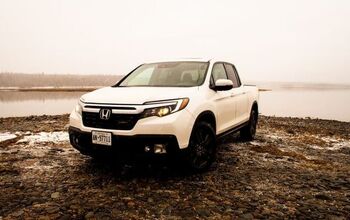Honda Ridgeline RTL Review
Strolling through one of Honda's vanilla dealerships and coming across the new Ridgeline is a bit like happening upon Mike Tyson supping Earl Grey tea at the Dorchester Hotel in London. Not that you'd say it out loud, but the word that springs to mind is 'fugly'. Which doesn't really do Honda's first-ever pickup truck justice. For better or worse, the Ridgeline is right hook to your aesthetic expectations, instantly redefining the pickup genre in both form and function.
Even at first glance, the Ridgeline's design makes it abundantly clear that we're not in Marlboro Country anymore. Dead on, the pickup's pointy proboscis mates an overgrown heating element salvaged from a fancy toaster with a pair of disagreeably squinty headlamps. Dramatic, over-square fenders, scalloped door skins and signature buttresses (connecting the Ridgeline's cab with its five foot composite bed) continue the outré theme. Out back, the look is somewhat cleaner, courtesy of a body-colored step bumper bracketed by elegant, wrap-around tail lamps. Unusually, the Ridgeline's tailgate lip is slightly lower than the bed's side rails; which greatly aids rearward visibility when reversing.
Inside, Honda's newfound proclivity for exaggerated design continues with an oddly peaked instrument binnacle hood, elephantine carabiner-esque metal-effect door pulls and oversized knurled switchgear. The expanding-drawer center console offers drivers a wide selection of compartments to lose things in. Fortunately, the Ridgeline's ergonomics are as sensible as the design is extreme. All the controls are well-designed and well-placed, though many plastics feel decidedly discount in light of the RTL's price tag and raised specification. Our army-surplus green tester came loaded to the sills with power leather chairs, dual-zone HVAC, moonroof, sat-nav and a thumpin' six-cd stereo with XM. The flip-up seat squabs in the back are the cabin's only real disappointment; they're stiffer than a porn star and more tiresome than a Senate filibuster.
The Ridgeline is the first mass market pickup built with a closed-box hybrid ladder frame (picture a traditional pickup ladder frame mated to a unibody like stinkbugs in heat). This novel architecture delivers much greater bending resistance than the average pickup, which enhances the truck's payload capability. It also leaves room for a sophisticated independent rear suspension, employing a multilink with trailing arm and anti-roll-bar. At a stroke, Honda's boffins have finally solved the genre's mid-corner axle tramp and stiff-legged ride (especially when the bed's vacant).
The new technology also raises the handling bar. While the Ridgeline is no S2000, it'll certainly scupper Toyota Tacomas in the twisties. The Ridegline's remarkable rear end composure gives drivers enough confidence to take liberties with the speed-sensitive power rack-and-pinion helm. And while the 17" 245/65 Michelin LTX's high profiles take a toll on ultimate cornering progress, they break away predictably and with minimal drama. For the truly overzealous, Ridgeline's standard stability control is a comforting safety net, and it isn't overly intrusive when driving at 8/10ths.
In fact, the Ridgeline's handling envelope is similar to Honda's own Pilot. Unlike the latter, the Ridegline will gamely tow up to 5,000 lbs. worth of 'lifestyle accessories' and hobbyist detritus. (Figure a couple of Ski-Doos or something small, fragile, and smote with Lucas electrics.) Of course, you'll have to leave stump pulling to conventional full-sizers, but don't expect urban cowboys to be crying into their soy lattes about it.
The Ridgeline's party trick is its first-for-a-pickup integrated trunk. It's a clever invention that inspires illicit thoughts of border-trafficking in even the most law-abiding of citizens. The lockable coffer will also swallow a weekend's worth of camping provisions for two, or enough Canadian pharmaceuticals to keep grandpa's nursing home in hydrocortisone for months. Access is easy, courtesy of a clever dual-action tailgate that swings wide like a car door. Better still, the tailgate can support some 300lbs. when lowered, an important detail given the Ridgeline's abbreviated bed.
Although it's down a couple of cylinders on the big boys, Honda's 3.5L V6 still has sufficient grunt to haul your sundries without complaint. Whether or not it could charge through mountainous terrain when loaded with ALL and sundry remains an open question. Unlike Honda's other 3.5L installations, the Ridgeline's drivetrain offers genuine aural character. The five-speed slushbox's super-smooth kickdowns create the kind of meaty growl that pickup truck aficionados covet. And when it's time for the soundtrack to stop, the Ridgeline's four-wheel discs– nannied by four-channel ABS, stability control and electronic brakeforce distribution– are the business.
In the end, the price of Ridgeline's utilitarian brilliance is aesthetic overload. Which makes the Honda Ridegline a fine choice for iconoclasts, provided they don't mind enduring the occasional truck guy barb about its (ahem) challenging visuals. To which there is only possible retort: "She ain't much to look at, but she sure can cook". Or, if you prefer, Ridgeline is Japanese for Git 'Er Done.
More by Admin
Latest Car Reviews
Read moreLatest Product Reviews
Read moreRecent Comments
- Kmars2009 I rented one last fall while visiting Ohio. Not a bad car...but not a great car either. I think it needs a new version. But CUVs are King... unfortunately!
- Ajla Remember when Cadillac introduced an entirely new V8 and proceeded to install it in only 800 cars before cancelling everything?
- Bouzouki Cadillac (aka GM!!) made so many mistakes over the past 40 years, right up to today, one could make a MBA course of it. Others have alluded to them, there is not enough room for me to recite them in a flowing, cohesive manner.Cadillac today is literally a tarted-up Chevrolet. They are nice cars, and the "aura" of the Cadillac name still works on several (mostly female) consumers who are not car enthusiasts.The CT4 and CT5 offer superlative ride and handling, and even performance--but, it is wrapped in sheet metal that (at least I think) looks awful, with (still) sub-par interiors. They are niche cars. They are the last gasp of the Alpha platform--which I have been told by people close to it, was meant to be a Pontiac "BMW 3-series". The bankruptcy killed Pontiac, but the Alpha had been mostly engineered, so it was "Cadillac-ized" with the new "edgy" CTS styling.Most Cadillacs sold are crossovers. The most profitable "Cadillac" is the Escalade (note that GM never jack up the name on THAT!).The question posed here is rather irrelevant. NO ONE has "a blank check", because GM (any company or corporation) does not have bottomless resources.Better styling, and superlative "performance" (by that, I mean being among the best in noise, harshness, handling, performance, reliablity, quality) would cost a lot of money.Post-bankruptcy GM actually tried. No one here mentioned GM's effort to do just that: the "Omega" platform, aka CT6.The (horribly misnamed) CT6 was actually a credible Mercedes/Lexus competitor. I'm sure it cost GM a fortune to develop (the platform was unique, not shared with any other car. The top-of-the-line ORIGINAL Blackwing V8 was also unique, expensive, and ultimately...very few were sold. All of this is a LOT of money).I used to know the sales numbers, and my sense was the CT6 sold about HALF the units GM projected. More importantly, it sold about half to two thirds the volume of the S-Class (which cost a lot more in 201x)Many of your fixed cost are predicated on volume. One way to improve your business case (if the right people want to get the Green Light) is to inflate your projected volumes. This lowers the unit cost for seats, mufflers, control arms, etc, and makes the vehicle more profitable--on paper.Suppliers tool up to make the number of parts the carmaker projects. However, if the volume is less than expected, the automaker has to make up the difference.So, unfortunately, not only was the CT6 an expensive car to build, but Cadillac's weak "brand equity" limited how much GM could charge (and these were still pricey cars in 2016-18, a "base" car was ).Other than the name, the "Omega" could have marked the starting point for Cadillac to once again be the standard of the world. Other than the awful name (Fleetwood, Elegante, Paramount, even ParAMOUR would be better), and offering the basest car with a FOUR cylinder turbo on the base car (incredibly moronic!), it was very good car and a CREDIBLE Mercedes S-Class/Lexus LS400 alternative. While I cannot know if the novel aluminum body was worth the cost (very expensive and complex to build), the bragging rights were legit--a LARGE car that was lighter, but had good body rigidity. No surprise, the interior was not the best, but the gap with the big boys was as close as GM has done in the luxury sphere.Mary Barra decided that profits today and tomorrow were more important than gambling on profits in 2025 and later. Having sunk a TON of money, and even done a mid-cycle enhancement, complete with the new Blackwing engine (which copied BMW with the twin turbos nestled in the "V"!), in fall 2018 GM announced it was discontinuing the car, and closing the assembly plant it was built in. (And so you know, building different platforms on the same line is very challenging and considerably less efficient in terms of capital and labor costs than the same platform, or better yet, the same model).So now, GM is anticipating that, as the car market "goes electric" (if you can call it that--more like the Federal Government and EU and even China PUSHING electric cars), they can make electric Cadillacs that are "prestige". The Cadillac Celestique is the opening salvo--$340,000. We will see how it works out.
- Lynn Joiner Lynn JoinerJust put 2,000 miles on a Chevy Malibu rental from Budget, touring around AZ, UT, CO for a month. Ran fine, no problems at all, little 1.7L 4-cylinder just sipped fuel, and the trunk held our large suitcases easily. Yeah, I hated looking up at all the huge FWD trucks blowing by, but the Malibu easily kept up on the 80 mph Interstate in Utah. I expect a new one would be about a third the cost of the big guys. It won't tow your horse trailer, but it'll get you to the store. Why kill it?
- Lynn Joiner Just put 2,000 miles on a Chevy Malibu rental from Budget, touring around AZ, UT, CO for a month. Ran fine, no problems at all, little 1.7L 4-cylinder just sipped fuel, and the trunk held our large suitcases easily. Yeah, I hated looking up at all the huge FWD trucks blowing by, but the Malibu easily kept up on the 80 mph Interstate in Utah. I expect a new one would be about a third the cost of the big guys. It won't tow your horse trailer, but it'll get you to the store. Why kill it?





































Comments
Join the conversation
I think the Ridgeline is the perfect truck for somebody who has no business driving a truck, but wants one anyway.